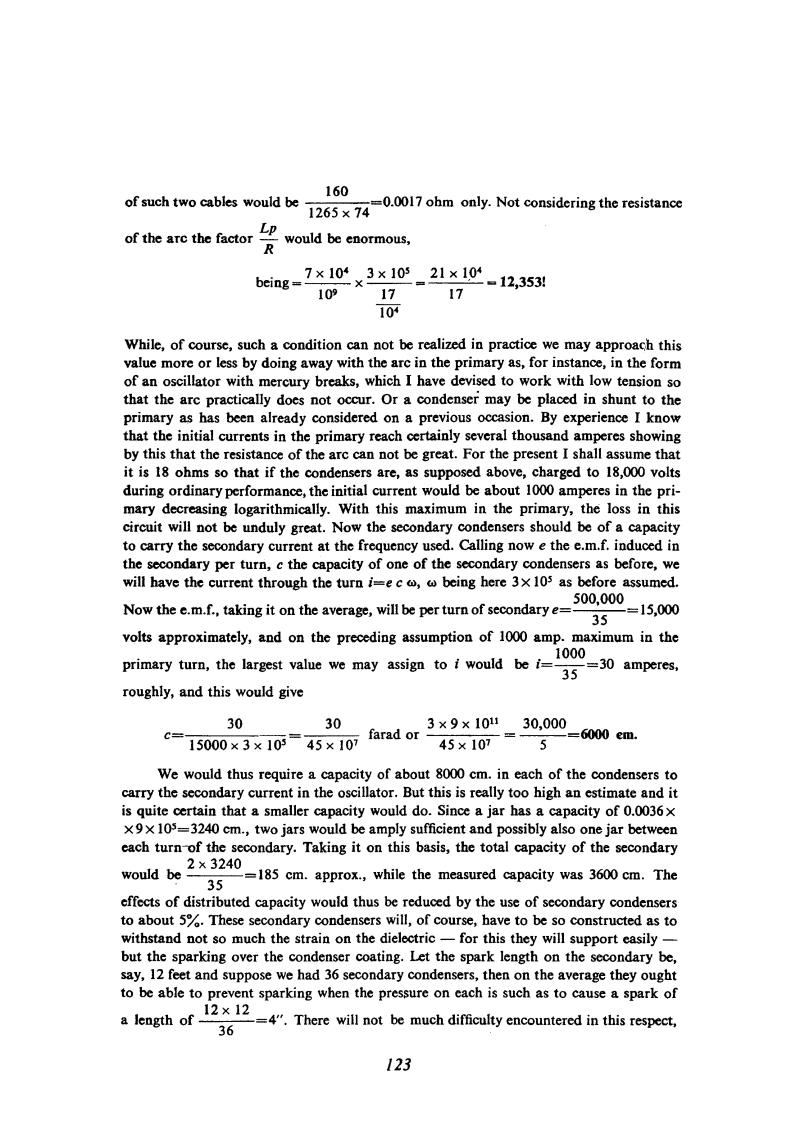
Nikola Tesla Books
of such two cables would be $! {{160 \over {1265 \times 74}} = 0.0017} $! ohm only. Not considering the resistance of the arc the factor $! {Lp \over R} $! would be enormous,
being $! {= {{7 \times 10^{4}} \over 10^{9}} = {{3 \times 10^{5}} \over {17 \over 10^{4}}} = {{21 \times 10^{4}} \over 17} =} $! 12,353!
While, of course, such a condition can not be realized in practice we may approach this value more or less by doing away with the arc in the primary as, for instance, in the form of an oscillator with mercury breaks, which I have devised to work with low tension so that the arc practically does not occur. Or a condenser may be placed in shunt to the primary as has been already considered on a previous occasion. By experience I know that the initial currents in the primary reach certainly several thousand amperes showing by this that the resistance of the arc can not be great. For the present I shall assume that it is 18 ohms so that if the condensers are, as supposed above, charged to 18,000 volts during ordinary performance, the initial current would be about 1000 amperes in the primary decreasing logarithmically. With this maximum in the primary, the loss in this circuit will not be unduly great. Now the secondary condensers should be of a capacity to carry the secondary current at the frequency used. Calling now e the e.m.f. induced in the secondary per turn, c the capacity of one of the secondary condensers as before, we will have the current through the turn i=e c Ï, Ï being here 3 x 105 as before assumed. Now the e.m.f., taking it on the average, will be per turn of secondary e = $! {500,000 \over 35} $! = 15,000 volts approximately, and on the preceding assumption of 1000 amp. maximum in the primary turn, the largest value we may assign to i would be i = $! {1000 \over 35} $! = 30 amperes, roughly, and this would give
$! {c = {30 \over {15000 \times 3 \times 10^{5}}} = {30 \over {45 \times 10^{7}}}} $! farad or $! {{{3 \times 9 \times 10^{11}} \over {45 \times 10^{7}}} = {30,000 \over 5} =} $! 6000 cm.
We would thus require a capacity of about 8000 cm. in each of the condensers to carry the secondary current in the oscillator. But this is really too high an estimate and it is quite certain that a smaller capacity would do. Since a jar has a capacity of 0.0036 x 9 x 105 = 3240 cm., two jars would be amply sufficient and possibly also one jar between each turn of the secondary. Taking it on this basis, the total capacity of the secondary would be $! {{2 \times 3240} \over 35} = 185 $! cm. approx., while the measured capacity was 3600 cm. The effects of distributed capacity would thus be reduced by the use of secondary condensers to about 5%. These secondary condensers will, of course, have to be so constructed as to withstand not so much the strain on the dielectric - for this they will support easily - but the sparking over the condenser coating. Let the spark length on the secondary be, say, 12 feet and suppose we had 36 secondary condensers, then on the average they ought to be able to prevent sparking when the pressure on each is such as to cause a spark of a length of $! {{12x12} \over 36} = 4\text{"} $!. There will not be much difficulty encountered in this respect,
123
July 31
Tesla made the capacitors for primary circuit from mineral water bottles filled with a saturated solid salt solution. He then submerged several bottles in a metal tank filled with the same solution. By that method he obtained the capacitor groups with a common layer. Other layers (electrolyte in jars) could have been connected in parallel as desired. The least capacitance change of capacitor battery of this type amounted to exactly the capacitance of one jar. By performing the withstand tests on such capacitors at a frequency of 144 Hz he concluded that they could withstand even 30,000 volts when two series of them are connected in series. By so solving the capacitor problems in primary circuit, he returns again to the secondary circuit. In the secondary he hadn't yet solved the problem of coil distributed capacitance, in which he sees the main obstacle on the way of achievement of desirable high voltages. Tesla's analysis, somewhat strange for a reader of these days (sometimes even incorrect) as hosed on a limited number of facts, impressed with its breadth. Tesla deeply penetrates in physical processes, and attempts to understand what and how something happens. His experiments provide him with proofs for conclusions he came to on the basis of thinking and analysis of previous experiments.
By having a desire to design the secondary coil with minimal self-capacitance, and which will be able to operate at extraordinary high voltages, Tesla devoted his time, more than anybody else before him, to a study of coils. The results were not lacking (coil shapes, winding methods), but with all that Tesla was not satisfied. He thinks what would happen when he would add series capacitors, and what would happen if he could change the distance between windings, or the wire diameter, etc.

